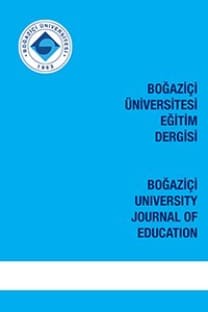Okulöncesi Eğitimde Bilgisayarın Yeri ve Rolü
Öz
Giderek daha karmaşık ve teknoloji ile donatılmış hale gelen bir dünyada, eğitimin her alanında olduğu gibi okulöncesi eğitimde de bilgisayar teknolojiler, öğretim programlarına dâhil ediliyor. Ancak eğitsel tüm araç ve gereçlerde olduğu gibi bilgisayarın da tek başına olumlu bir katkı yapması beklenemez. Bilgisayar teknolojilerinin okul öncesi eğitimdeki yeri ve rolü araştırılıp sorgulanmalı ve bütüncül bir yaklaşım çerçevesinde değerlendirilerek izlenmesi gereken yol tespit edilmelidir. Bu makalede bilgisayar teknolojilerinin eğitimdeki yerine dair güncel yaklaşımlar ve okul öncesi eğitimdeki uygulama biçimleri gözden geçirildikten sonra okul öncesi eğitimdeki rolü tartışılıyor; bazı örnek uygulamalar tarif edilerek eğitimcilere pratik tavsiyelerde bulunuluyor.
Anahtar Kelimeler:
Okulöncesi eğitimi ve bilgisayar, teknoloji entegrasyonu, çoklu öğrenme ortamları
___
- Bransford, J. D., Sherwood, R.D., Hasselbring, T. S., Kinzer, C. K., & Williams, S.M. (1990). Anchored instruction: Why we need it and how can technology help? D. Nix & R. Spiro (Haz.) Cognition, education, and multimedia (s. 115- 141). Hillsdale, N.J.: Lawrence Erlbaum Associates.
- Bransford, J. D., Brown A., Cocking R. (2000). How people learn: Brain, mind, experience, and school. National Research Council.
- Clark, R. C., & Mayer, R. E. (2003). E-learning and the science of instruction. San Francisco: Pfeiffer.
- Cuban, L. (2003). Oversold and underused: Computers in the classroom. Cambridge, M.A.: Harvard University Press.
- Davis, B. C., & Shade, D. D. (1999). Integrating technology into the early childhood classroom: The case of literacy learning. Information Technology In Childhood Education, 221-254.
- Haugland, S. W., & Wright, J. L. (1997). Young children and technology: A world of discovery. Boston: Allyn and Bacon.
- Healy, J. M. (1999). Failure to connect: How computers affect our children’s minds— and what we can do about it. New York: Touchstone.
- Heinich, R., Molenda, M., Russell, J., Smaldina, S. (2002). Instructional media and technologies for learning. Upper Saddle River, N.J.: Merill Prenctice Hall.
- Hutinger, P. L., & Johanson, J. (2000). Implementing and maintaining an effective early childhood comprehensive technology system. Topics in Early Childhood Special Education 20, 3.
- Jonassen, D. (2000). Computers as mindtools for schools. Upper Saddle River, N.J.: Prentice Hall Inc.
- Jonassen, D. H. (2006). Modeling with technology: Mindtools for conceptual change. Upper Saddle River, N.J.: Pearson Merrill Prentice Hall.
- Lajoie, S. P. (2000). Computers as cognitive tools, Volume two: No more walls. Mahwah, N.J.: Lawrence Erlbaum Associates.
- Lajoie, S. P., & Derry, S. J. (1993). Computers as cognitive tools. Hillsdale, N.J.: Lawrence Erlbaum Associates.
- Laurillard, D. (2002). Rethinking university teaching: A conversational framework for the effective use of learning technologies. London: Routledge Falmer.
- NAEYC. (1996). Technology and Young Children – Ages 3 through 8. National Association for the Education of Young Children, Washington, DC. http://www.naeyc.org/resources/position_statements/positions_intro.htm
- Mioduser, D., Tur-Kaspa, & H., Leitner, I. (2000) The learning value of computer-based instruction of early reading skills. Journal of Computer Assisted Learning 16, 54-63.
- Nicolson, R.I., Fawcett, A. J., & Nicolson, M. K. (2000). Evaluation of a computer- based reading intervention in infant and junior schools. Journal of Research in Reading, 23(2), 194-209.
- Nir-Gal, O., & Klein, P. S. (2004). Computers for cognitive development in early childhood. The teachers' role in the computer learning environment. Information Technology in Childhood Education Annual, (1), 97-119.
- Plowman, L. (1996). Designing interactive media for schools: A review based on contextual observation, Information Design Journal, 8(3), 258-266.
- Plowman, L., & Stephen, C. (2005). Children, play, and computers in pre-school education. British Journal of Educational Technology, 36(2), 145–157.
- Roblyer, M.D. (2006). Integrating educational technology into teaching. Upper Saddle River, N.J.: Merill Prentice Hall.
- Stephen, C., & Plowman, L. (2003) Information and communication technologies in pre- school settings: A review of the literature. International Journal of Early Years Education (11) 3.
- Turnbill, J. (2001). A researcher goes to school: Using technology in the Kindergarten literacy curriculum. Journal of Early Childhood Literacy 1(3), 255–279.
- Tyack, D., & Cuban, L. (2000). Teaching by machine. R. Pea (Haz.), The Jossey-Bass reader on technology and learning (s. 247-254). San Fransisco: Jossey- Bass.
- Wegerif, R., & Dawes, L. (2004). Thinking and learning with ICT: Raising achievement in primary classrooms. New York: Routledge Falmer.
- Yelland, N. (2005). Curriculum practice and pedagogies with ICT in the information age. N.J. Yelland (Haz.) Critical issues in early childhood. (s. 224- 242). Buckingham, BK: OUP.
- ISSN: 1300-9567
- Yayın Aralığı: 3
- Başlangıç: 1976
- Yayıncı: Boğaziçi Üniversitesi
